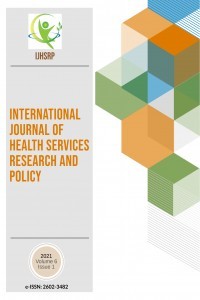DOES DISABILITY STATUS AFFECT MATERNAL CARE AROUND PREGNANCY? EVIDENCE FROM NATIONAL SURVEY OF FAMILY GROWTH (NSFG) 2013-2015 DATA IN UNITED STATES
DOES DISABILITY STATUS AFFECT MATERNAL CARE AROUND PREGNANCY? EVIDENCE FROM NATIONAL SURVEY OF FAMILY GROWTH (NSFG) 2013-2015 DATA IN UNITED STATES
Abstract Introduction It is estimated that approximately 12% of the reproductive age women have some kind of disability; which is measured as self-reported difficulty in performing basic functions concerning movement, vision, hearing or cognition. Little research has been conducted on reproductive health of women with disabilities using nationally representative survey data; thus body of scientific knowledge on this subject is limited. Objectives The purpose of this study was to examine the effect of disability status (both mental and physical) among women on prenatal care and post-pregnancy care in U.S. using nationally representative National Survey of Family Growth (NSFG) data. Study design It’s a retrospective, quantitative, observational study. Methods The 2013-2015 NSFG’s female respondent file contains 5699 records one for each woman interviewed whereas the pregnancy respondent file contains 9358 records each related to a pregnancy. The data about disabilities related variables was part of female respondent file therefore using unique respondent ID files were merged and logistic regression models were built using prenatal and postnatal care as dependent and disability status as main independent variable. Results Women with Medicaid were significantly less likely as compared to those with private insurance to have received prenatal care in last 12 months. Women with less than 12 years education were less likely to have received post pregnancy care as compared to those with college education. Conclusion: Although this study did not find significant effects of disability on utilization of prenatal and post-pregnancy care, further research is needed on this subject with datasets that include comprehensive information about broader spectrum of disability status of women.
Keywords:
Maternal health, , Disparities in access to maternal health, , health disparities in United States, pregnancy among women with disabilities, ,
___
- 1- Horner-Johnson, W., Biel, F. M., Caughey, A. B., & Darney, B. G. (2019). Differences in Prenatal Care by Presence and Type of Maternal Disability. American Journal of Preventive Medicine, 56(3), 376-382. doi:10.1016/j.amepre.2018.10.021
- 2- Mitra, M., Clements, K. M., Zhang, J., Iezzoni, L. I., Smeltzer, S. C., & Long-Bellil, L. M. (2015). Maternal Characteristics, Pregnancy Complications, and Adverse Birth Outcomes Among Women With Disabilities. Medical Care, 53(12), 1027-1032. doi:10.1097/mlr.0000000000000427
- 3- Morton, C., Le, J. T., Shahbandar, L., Hammond, C., Murphy, E. A., & Kirschner, K. L. (2012). Pregnancy Outcomes of Women With Physical Disabilities: A Matched Cohort Study. Pm&r, 5(2), 90-98. doi:10.1016/j.pmrj.2012.10.011
- 4- Horner-Johnson, W., Darney, B. G., Kulkarni-Rajasekhara, S., Quigley, B., & Caughey, A. B. (2016). Pregnancy among US women: Differences by presence, type, and complexity of disability. American Journal of Obstetrics and Gynecology, 214. doi:10.1016/j.ajog.2015.10.929
- 5- Kuh, D. (2003). Life course epidemiology. Journal of Epidemiology & Community Health, 57(10), 778-783. doi:10.1136/jech.57.10.778
- 6- Jacob, C.M.; Baird, J.; Barker, M.; Cooper, C.; Hanson, M. The Importanceof aLife-Course Approach toHealth: Chronic Disease Riskfrom Preconception Through Adolescence andAdulthood; Technical Report; World Health Organization: Geneva, Switzerland, 2017
- 7- Hanson, M. A., Cooper, C., Sayer, A. A., Eendebak, R. J., Clough, G. F., & Beard, J. R. (2016). Developmental aspects of a life course approach to healthy ageing. The Journal of Physiology, 594(8), 2147-2160. doi:10.1113/jp270579
- 8- Russ, S. A., Larson, K., Tullis, E., & Halfon, N. (2013). A Lifecourse Approach to Health Development: Implications for the Maternal and Child Health Research Agenda. Maternal and Child Health Journal, 18(2), 497-510. doi:10.1007/s10995-013-1284-z
- 9- NSFG - National Survey of Family Growth Homepage. (n.d.). Retrieved from https://www.cdc.gov/nchs/nsfg/index.htm
- 10- 2013-2015 National Survey of Family Growth USER S GUIDE. (n.d.). Retrieved from https://www.cdc.gov/nchs/data/nsfg/nsfg_2013_2015_userguide_maintext.pdf
- 11- Bloom, T. L., Mosher, W., Alhusen, J., Lantos, H., & Hughes, R. B. (2017). Fertility Desires and Intentions Among U.S. Women by Disability Status: Findings from the 2011–2013 National Survey of Family Growth. Maternal and Child Health Journal, 21(8), 1606-1615. doi:10.1007/s10995-016-2250-3
- 12- NSFG - 2013-2015 NSFG - Questionnaires. (n.d.). Retrieved from https://www.cdc.gov/nchs/nsfg/nsfg_2013_2015_questionnaires.htm#female
- 13- NSFG FEMALE CRQ FOR 2013-2015 ,OMB Number 0920-0314 , accessed on the web at https://www.cdc.gov/nchs/data/nsfg/nsfg_2013-15_femh_crq.pdf
- 14- 2013-2015 National Survey of Family Growth , Users Guide. (n.d.). Retrieved April 5, 2019, from https://www.cdc.gov/nchs/nsfg/nsfg_2013_2015_puf.htm
- 15- 2013-2015 NSFG user’s guide appendix 2: SAS and STATA syntax guidelines for common file manipulations retried April 5, 2019, from https://www.cdc.gov/nchs/data/nsfg/NSFG_20132015_UG_App2_FileManipulations_rev.pdf
- Yayın Aralığı: Yılda 3 Sayı
- Başlangıç: 2016
- Yayıncı: Rojan GÜMÜŞ
Sayıdaki Diğer Makaleler
Sanjida NEWAZ, Natalie RIEDIGER
PERIOPERATIVE NURSING CARE IN CASES REQUIRING EMERGENCY SURGERY IN COVID-19 INFECTED PATIENTS
Remziye CİCİ, Esra ANUŞ TOPDEMİR
Zühre KAYA, Serap KİRKİZ, Meryem ALBAYRAK, Esra GÜNEY, Selin AYTAC, Namık Yaşar ÖZBEK
FREQUENCY OF DAYTIME SLEEPINESS OF FACTORY WORKERS WORKING IN SHIFTS AND ITS EFFECT ON ANXIETY
Sanidin KANTAR, Rabia SOHBET, Fatma KARASU, Canan BİRİMOGLU OKUYAN
DETERMINING THE RELATIONSHIP BETWEEN PRESENTEEISM AND ORGANIZATIONAL SUPPORT IN NURSING
Firat SAHİN, Murat AKKUŞ, Uğur ŞEKER, Sevda SOKER, Ebru GOKALP-OZKORKMAZ, Elif AĞAÇAYAK, Fırat AŞIR
